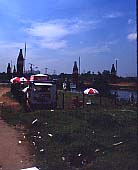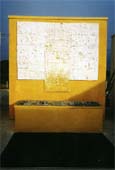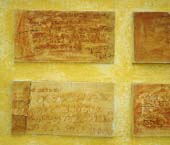
about
the author
print version
print version
O'
T
F
The
visitor is guided
through a system
of colored paths
forming around
the pile a shape
of an eye.
(This
reminds me on
a methaphor we
have in German:'ein
Dorn im Auge sein',
which means that
there is something
in the eye, that
disturbes you
and remindes you
on something you
don't like to
think on)
On
the farther side
of the hill we
find a standing
human figure,
the only real
sculpture in this
scene. It depicts
a young man, standing
straight, looking
ahead, with an
open jacket showing
his flayed, injured,
hurt, breast.
The artist mentioned
that he missed
in the concept
the representation
of the individual,
who had to suffer
the pain. This
is for me a very
understandable
argument looking
at the conceptual,
abstract concepts
of memorials in
the last ten years
where the depiction
of the individual
was neglected.
And he chooses
a position which
doesn't show the
victim in an oppressed
e.g. crawling
position, such
as we know them
from memorials
e.g. by George
Segal, where the
sculpture orients
itself at the
striking pictures
of the piles of
dead bodies found
in the concentration
camps after the
Second World War.
Jagath chooses
the standing upright
position showing
very much the
dignity of the
wounded. This
standing position
is traditionally
used in monuments
for statesman.
If we distinguish monuments according to a typology we find three types: equestrian statues, the standing and the sitting sculptures. In the Western World and probably everywhere else they are distributed according to their social position: only monarchs and high ranking military men like generals are allowed to sit on a horse. Statesmen are standing, poets, philosophers and others are sitting.(Cullen 1999, p.31)
I like this idea of giving back the dignity to the violated victim and this straight look into the future. But I would see this concept of a high evaluation of the body and the individual in the tradition of a western art concept.
Combining Eastern
and Western art
traditions and
forms
Altogether I see
this memorial
as a very impressive
combination of
Eastern and Western
art traditions
which support
its universal
idea. Referring
to western art
traditions and
form we can mention
the sculpture,
the pedestials-stelen
with the abstract
heads and the
triptych. On first
sight the inner
room with its
clear structure
and reduced, abstract
forms makes it
part of contemporary
art concepts.
But on a closer
look the triptych
can also be seen
as a mandala,
the altar as a
mal asna (or the
other way round).
This can be seen
as a combination
of Western and
Asian art traditions
or as a realization,
that basic visual
forms refer to
similar meanings
and lead the spectator
back to essential
ideas: The triptych
or mandala as
a point of concentration
and meditation,
the structure
of a sacral room
as a place for
commemoration
and worship, the
altar or mal asna,
not in a specific
religious, but
spiritual meaning
and so on.
In the outside
area there seem
to be more forms
and symbols referring
to Sri Lankan
tradition, the
guardian figures,
the guardian stones
with the snake,
the portal figures
of the gods etc.
Symbols that are
very present and
can be found in
everyday life
like on newly
built houses,
entrances etc.
giving the meaning
of protection.
Common symbols
that are understood
very well and
might attract
people and make
them interested
enough to go inside.
Now it seems interesting
to me as Jagath
Weerasinghe told
me that the workers
staying there
said that the
people are frightened
and talk about
evil spirits which
are supposed to
be in this area.
So the intention
of the guardian
figures as protectors
is contradicted.
Do the people
have a bad conscience,
are they afraid
of their own inherent
dark sides or
is it merely the
presence of the
depicted demons
...?
A
part of every
day culture
With
these aspects
the memorial refers
very much to the
every day culture
of Sri Lanka.
They refer to
the non-written
form of a cultural
self-awareness.
In the sense that
Jan Assmann has
defined the term
cultural memory.
(Assman,
Jan: das kulturelle
Gedächnis.
Schrift Erinnerung
und politische
Identität
in den frühen
Hochkulturen,
München 1992.)
This cultural
memory doesn't
exist but has
to be created.
In the non written
aspects of culture
the repetition
of something has
an important meaning,
like the configuration
of letters which
give words a persistence.
Dance, games,
masks, pictures,
songs, food, places
and rooms, clothes
and so on can
be part of the
`self assertion`(Selbstvergewisserung)
and `self realization`
(Selbstvergegenwärtigung)
of a society.
In this context but also as part of a process oriented art form - which was mainly used in the nineties for memorials - the involvement of the visitor must be mentioned. Already on his way into the memorial he is supposed to be put on a platform to change his perspective, to become aware of his own standpoint, his role in this scene. The spectator with his own perception becomes part of the concept. Only with the reception of an individual does the memorial come alive.
But the most important
point in this
sense is that
the memorial can
be used as a place
of commemoration.
In all human societies
we find the necessity
of commemorating
ancestors, history
and past. But
some cultures
stress the importance
of commemoration
less, others more.
The differing
importance of
commemoration
is a complex system
rising out of
ritual, mystical,
historical, political,
sociological and
psychological
factors and conditions.
Contemporary Sri
Lankan society
seems to weave
the memory especially
of its deaths
much more into
every day life
than I find in
Germany.
The laying out
of a dead body
in the house,
the decoration
of the house and
the street with
pictures and garlands,
the open transport
of the coffin
or the covered
dead body is very
much part of street
life.
Though we can
find traditionally
similar rites
in Germany e.g.
the laying-out.
In our days with
the existence
of the undertaker
the dead body
disappears very
fast into an invisible
technical surrounding
and is no longer
visual part of
the everyday life.
Also the commemoration
of the deaths
with advertisements
in the newspapers
at the anniversary
of the death,
the invitation
of monks and their
ceremonies, the
rites in the temple
indicate a very
lively commemoration
of the deaths
by people in Sri
Lanka.
As mentioned,
basically we find
similar rites
in Germany e.g.
the 1th of November
is the memorial
day for all the
dead but only
older people use
this day to light
a candle in the
graveyard. For
the younger generation
this act seems
very unusual.
So altogether
the commemoration
of the deaths
which means of
its own past and
tradition seem
for me very much
rigorous in Sri
Lanka. It might
be that these
traditions can
be transferred
to a universal
sense, if the
modern Sri Lankan
society doesn't
forget or lose
its lively traditions
of commemorating
the ancestors.
By combining those
elements with
traditional and
modern Sri Lankan
and Western art
forms, the memorial
might be able
to make a contribution
to this development.
So the interaction
between the memorial
and its visitor
can be seen as
essential.
Only a memorial
that is discussed
in everyday life
and accepted in
rituals can be
a reminder to
rethink the past
for a reflection
of the present
situation
In this sense
I wish the Shrine
of the Innocents
a lot of visitors.
(This
text will be presented
with a further
theoretical introduction
at the 'International
Conference Europe
and South-Asia
- Plural Identities,
Multiple Perspectives',
organised by the
delegation of
the European Commisson
in association
with The Centre
for European Studies
of the Kelania
University on
Feb. 24th,2000.
All presented
papers will be
published after
the congress.)
'THE
SHRINE OF INNOCENTS'
THE FIRST MEMORIAL
FOR THE VICTIMS
OF THE ONGOING
CONFLICT IN SRI
LANKA
Going from Battaramulla
to Kelaniya or
Colombo I pass
the location where
the memorial 'The
Shrine of Innocents'
was built during
the last months.
So I could see
the development
of this place,
which caught my
interest. Some
weeks ago I visited
the location with
the artist Jagath
Weerasinghe -
who is responsible
for the concept
- and we spoke
about the conception
and his ideas.
From this visit
and also from
the participation
in the inauguration
ceremony I was
very much impressed.
On December 10th
1999 the 'Shrine
of Innocents'
in Battaramulla
close to the parliament
was inaugurated.
The Initiators
This site with
its architecture,
sculpture and
installation is
meant as a memorial
of the victims
of Embilipitiya.
(In Embilipitiya
- 180 km south
of Colombo- 38
children and young
adults disappeared
between 1988 and
1989, when the
army seized them
for suspected
antigoverment
activism. After
a three year trial,
the situation
is still not clear.
7 people - including
6 soldiers and
a school principal
were tried for
abduction but
not for murder
as the remains
of the childen
were never found.
Residents say,
that when the
army shot down
the notorious
torture chamber
with a crushing
of the JVP in
1989 they had
to get rid of
the illegaly arrested
boys. Information
taken from an
article in The
Island: Embilipitiya
agony - parents
of missing childs
still sullen,
sunday Dec, 12th,
1999, page 5.)
As it is described
in Chandaratne
Bandaras text
in the handout
the parents from
many villages
and townships
throughout the
country made a
plea to Chandrika
Bandaranaike Kumaratunga,
the Sri Lankan
president since
1994, to raise
a place for the
commemoration
of their children
and relatives,
who were the victims
of Embilipitiya.
To realize such
a memorial site
is a remarkable
initiative of
a president during
an ongoing conflict.
Furthermore as
the author of
the handout and
the artist himself
stress, this memorial
cannot be reduced
to the commemoration
of one group of
victims, but must
also embrace "all
victims of organized
political violence
and terror in
all parts of our
(the) country,
irrespective of
region and the
communities that
were affected
by it."
(Quotation out
of the text of
Chandaratne Bandara
in the handout.)
A universal declaration
which condemns
all ongoing violence
and includes all
groups of victims.
The only restriction
the artist sets
with the title
is that the shrine
is meant only
for innocent victims.
Which reminds
me of a problem
we had in the
German discussion
commemorating
groups of victims
who can be guilty
and innocent at
the same time,
e.g. members of
the former German
army, the Wehrmacht.
A question which
influenced also
the discussion
about the central
holocaust memorial
in Berlin in1999.
On the other hand
the question is
what kind of political
function will
'The Shrine of
Innocents' have
in Sri Lanka in
the future?
In the presence
of an ongoing
conflict a memorial
has at least a
double function:
on one hand it
is meant as memory
for the victims
of Embilipitiya
for the parents
and relatives
but also for the
whole nation.
On the other hand
it makes us aware
that basically
the same conflict
exists today.
Which means the
function of this
monument is not
only commemoration
but also might
be a chance for
a reflection of
the present situation.
But under this
perspective might
it not also implement
an acceptance
of the situation
with the ongoing
conflict?
The
location
The location of
the memorial is
close to the new
parliament building,
a place of political
importance, and
a new established
public bathing
place beside the
main road going
from Colombo to
Battaramulla,
which give the
location also
an involvement
in every day life.
People pass by,
rest beside the
lake, become attracted
by the memorial
during activities
of their every
day life.
This involvement
means visually
that we find a
new sculpture
of a couple of
bathing mermaids
at the bathing
place close by
as well as big
posters of a Coca
Cola advertisement
and sometimes
political banners
at the roundabout
- a combination
which gives altogether
a very lively
impression.
But
the memorial is
still visually
strong enough
to persist. Looking
from outside you
see at first an
enclosed grassy
hill in front
of a peaceful
landscape of wetland.
I first was reminded
of a transformer
station or a bunker.
Then you become
curious as on
one side you notice
three big, dark
brown guardian
figures, on the
opposite side
five steps, in
bright orange
and outside a
pile of white
sticks.
The
site
Coming closer
to the entrance
you can see a
natural stone
which displays
on a tablet the
title `The shrine
of Innocents`
in Sinhala, Latin
and Tamil letters.
On the right there
is a head of a
giant, the protector
of the law and
the people, emerging
out of the earth
as far as the
top of his shield.
Beside the entrance
there are two
reliefs of female
goddesses, pointing
their index fingers
to the earth as
a symbolic connection
between the events
of the past, the
present and the
future.
Traditionally
there are gods
used as guardian
figures for temples,
as can be seen
e.g. in Pollonaruwa.
This uncommon
use of a goddesses
as guardian figure
refers to the
mythology of the
mother figure
goddess Kuveni,
who was deprived
of her two children.
The
visitor is lead
inside the memorial
by a black paved
path. For one
moment he finds
himself standing
on a small platform
which changes
his or her standpoint
and perspective
and might make
him or her aware
of his/her own
position inside
this arrangement.
From this standpoint
you realize that
there is an iterior:
A light open room
dominated by bright
yellow, orange
and ochre.
Inside the room are two separate fields of 19 white, waist high pedestals (steles) symbolizing the 38 children who were abducted and disappeared between 1988-89 in Embilipitiya. This form of stele is of Greek origin and was originally used as a gravestone. Today this form is very common in memorials usually set in a large number, as e.g. also in the latest concept of the memorial for Berlin which consits of hundreds of steles giving the impression of a moving surface of a sea.
The steles are erecting out of a layer of ochre colored clay objects. Their form and color remind us of bones. Each of them is mould by the hand of the parents and those involved in art, human rights and cultural activities who engaged themselves for the victims.
On each top of the steles we see an abstract, oval form which reminds us of a human scull. The irregular orange layer of their terracotta surface gives them a lively effect.
On
the opposite side
in front we look
onto a white and
light yellow triptych
with a round carved
structure, which
reminds us of
a sun, of a universal
complete form
with a warm and
bright effect.
Which can also
be seen as a mandala
or shri yantra
that can be used
for concentration
and meditation.
In front of this
is an altar (mal
asna) where people
can light oil
lamps or offer
flowers. On the
opposite walls
beside the entrance
there are each
25 clay tablets
on which the relatives
have carved their
wishes for the
dead.
The whole structure of this room reminds us of a sacred room but not dedicated to one of the Religions. It has a concentrating but bright and light atmosphere.Passing the altar we see again the five orange steps which might remind us in this context of the five steps of cognition of Buddhism.
Opposite the steps the white pile of sticks might remind us of a funeral pile or especially the Sri Lankans of an old children game: Enclosing an animal or a small sister or brother with wooden sticks until it escapes. According to the artist a very early form of - innocent(?)- violence and oppression in the society. An example for hidden, everyday cruelty, which opens the meaning of the commemoration site according to the intention of the artist to a universal meaning but also implies the ambivalence of victim and offender in one person.










